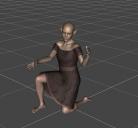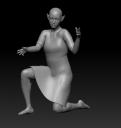Export of model from Daz3D to ZBrush
Hello,
I purchased clothing assets for Genesis 8 female - dForce Multi Dress System - and was able to use one of the dresses for some test poses (prntscrns included). I then tried both exporting as OBJ for import and the direct ZBrush integration to move the posed figure with dress to Zbrush for some addtional work.
As you can see from the screen shots, what I got in Zbrush wa not what I see in Daz3D. It actually looks like it exported the figure with the stock dress for the Dress System, (which you see in Daz before you select a particular dress style in the system).
Being new to Daz3D I'm at a loss on what to try next. I'm figuring there must be some option that 'bakes' the current state of the visible objects together that I'm not doing before the export, so it's reverting to the stock dress model? That's a newbie's guess from me, but appreciate any help from the experts here on what to try next.
Also, would it be easier to use Blender as an intermediary between Daz and Zbrush to faciliate this? Didn't think so, asking anyway.
Thank you!
Russell






Comments
I don't use ZBrush, but it looks like the dress uses transparencies to create the neckline and sleeves and in ZBrush you just got the pure mesh with no transparencies.
EDIT I just looked at the dress product and that is exactly what happened. What you see in ZBrush ios the complete dress without textures.
Are checking Export with Deformations in th dialogue box that opens after clicking Send to ZBrush?
Yes, I am checking the Export with Deformations checkbox before I send.
So given that the visual I am seeing includes these transparencies, is there a way to convert this to a workable mesh? Or are these transparencies really only a visual effect that does not correspond to a modification of the underlying mesh? If so, that's unfortunate because I bought the resource plus it's expansion believing I'd have lots of these dress 'meshes' to test. I effectively spend $40 for a stock dress mesh? LOL
As a follow up I did a search of the knowledge base and documentation for 'transparencies', but not finding pages that explain what they are and how they are used in the Daz. I'm at a disadvantage I assume in how to work around my issue if I don't understand transparencies and their use. But let me confirm first, because this 'dress' is using transparencies, does that mean that what I'm actually viewing in Daz is not an actual modified mesh, but a visually modified version of the stock/base dress?
Oh, I see. Transparency just makes areas see-through, depending on the colour of the map (black = transparent, white = opaque using the default values). The bridge to ZBrush does send over UVs, but not the surface groups so even if ZBrush uses opacity maps (which I can't recall) getting them set up can be tricky - especially if the model uses multiple overlapping UV tiles (as the Daz humans do).
I don't have ZBrush either but have been doing a LOT of conversion of Daz scenes to Lightwave. FBX, actually all of the export methods, only export the basic color or diffuse map & maybe a bump. Everything else has to be manually copied over from the Daz folder then set up at the recieving end. In some cases using a transp map, you might have to invert, that sort of thing.
I prefer using FBX, but it has some issues with more complex scenes where instancing is involved. For a single character with clothing, etc. you'll probably be fine.
Gotcha, so I'll haver to play with this a bit then, I don't think Zbrush uses opacity maps, and I rarely concern myself with UV maps (I might be one of the few artists here using both Zbrush and Daz to faciliate actual physical sculpture work?).
What about Blender as an intermediary? Or Maya? Would that be a simplier route to exporting the Daz model as it's visualized in Daz?
Thinking through this a bit more now, I can apply an alpha across a mesh and then mask by color, create a polygroup from that masked region, and then delete the geometry. It would be a bit of work however, and the dresh would have to export to Zbrush with the color information intact. RIght now their is no color information present on the exported model. That could actually make this work if I could apply the mapping to the dress in Zbrush, then manipulate the geometry as I just described.
If you delete geometry you won't be able to reimport the result as a morph. Hiding and then reshowing it should be safe.
is there a reason that the UV Map that gets imported into Zbrush doesn't have any color information related to the masking you menton? With that applied on the UV map I could do what I described above - in theory. That is, I could remask the area in Zbrush to create a transparency of sorts so I'm at least getting some consistency between the two application views.
It imports the mapping, the values that tel an application how to apply an image to the model - it doesn't import the maps, and it dosn't import the Surface groups which allow the user to have different settings for different areas.
Thank you Richard, so I attempted to create a dress in Zbrush off a stock figure. After testing that out, I've decided I don't have time for the learning curve to make it work as well as I would like.
So I am back to my first idea, of buying several dress assets on the Daz3D marketplace. But I don't want to make the same mistake of buying a visually appealing dress that really isn't a true mesh of the dress itself. Is there something listed in the descriptions of these clothing items that would indicate its a masking off some stock mesh as opposed to an actual dress mesh as is? I'm getting drawn in by all the great designs but if they are not going to export as they appear in daz, I'll make the same mistake again.
Opacity maps would indicate that soemthing was being done via hiding, but not what. Check the promo images - if the dress has different degrees of cut-out then assume that the extra holes/scoops are from maps rather than the mesh.
Usually, the transparency of clothing is controlled by the "Cutout" property in Surfaces.
This is generally a mask.
You can apply this mask in zbrush as a texture,
Create polypaint from texture
Create mask from color
and create a polygroup from the mask which you can use to delete the geometry or just to split the geometry and hide.
I missed this post.
Yes... The "color information" is just the original texture that comes with the dress mapped to the UVs. After deleting the unused group/geometry, you can simply apply this texture map in the texture palette. Just click Texture map and import it.
Also note, I'm not familiar with the dress product that you are using, but it may have UV groups already assigned for the transparency. Under Polygroups, click Auto Groups with UV. You may be able to just hide the group without having to do all the other steps.
Awesome Thor, I just happened to check this post again, but I am going to try what you're describing inside zbrush. And really appreciate the screenshots too!. After checking I did see UV groups for the dress I imported in Zbrush so I will try to Auto Group with UV, which I agree would be an easy route.
@rlongo_home Good luck... once you get the process down it's not too bad, and you can do a LOT of cool stuff using Daz and Zbrush.
For Daz imports you'll want to divide the mesh up to 5 subdivision levels when working with masks/textures. After grouping by mask, you'll want to use Deformation > Polish by groups (or Polish by features) in order to smooth the edges (the screenshots show the result after polishing the groups). After polishing you may also need to use Deformation > Inflate. In the 3rd screenshot you can see that I had inflated the swimsuit part, but not the legs (since i was going to delete them anyway).